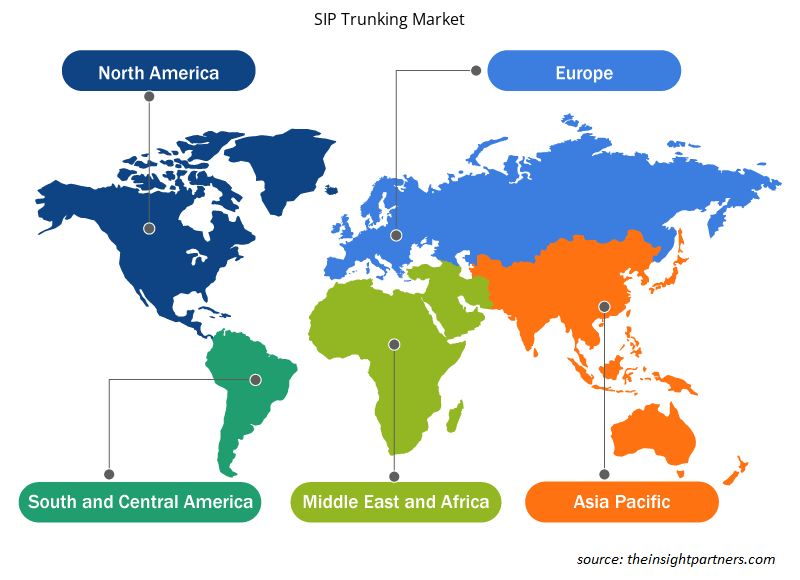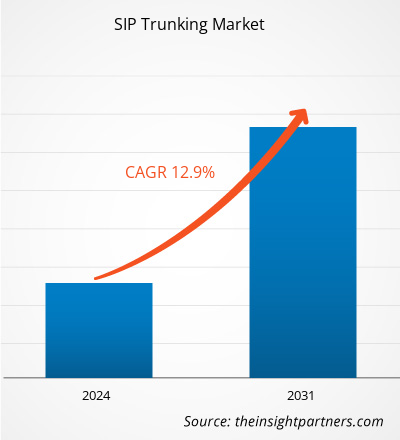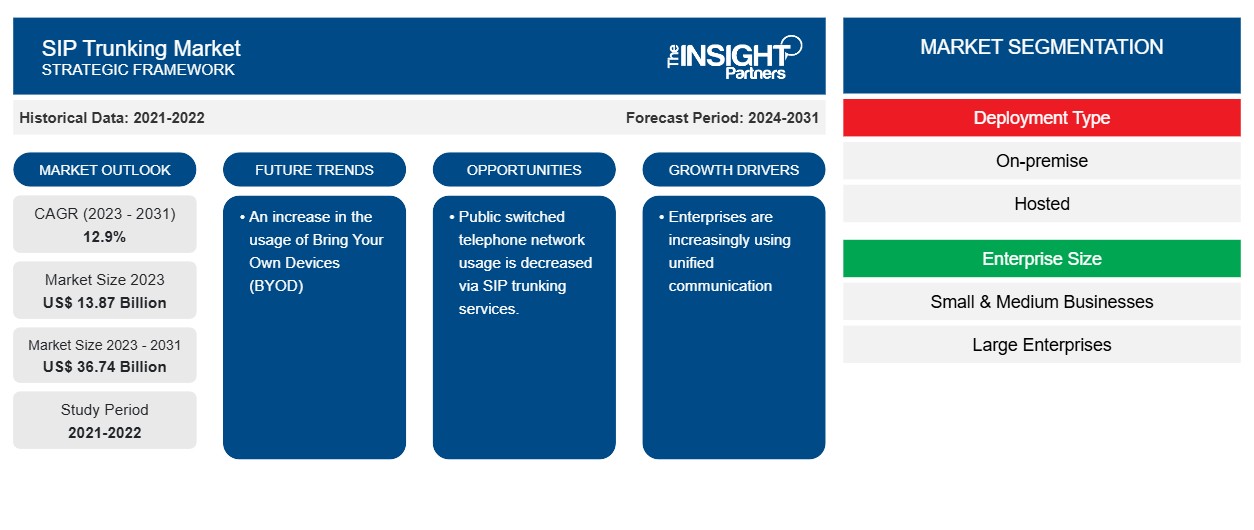Der SIP-Trunking-Markt soll von 13,87 Milliarden US-Dollar im Jahr 2023 auf 36,74 Milliarden US-Dollar im Jahr 2031 anwachsen. Der Markt soll in den Jahren 2023–2031 eine durchschnittliche jährliche Wachstumsrate (CAGR) von 12,9 % verzeichnen. Die weltweit zunehmende Nutzung von Bring Your Own Devices (BYOD) dürfte ein wichtiger Trend im SIP-Trunking-Markt bleiben.
SIP-Trunking-Marktanalyse
Der Bedarf an SIP-Trunking wird durch die zunehmende Nutzung von Unified Communications (UC)-Lösungen in Unternehmenskontexten, einen deutlichen Rückgang der Telefonkosten und einen schnellen Return on Investment (ROI) durch die Trunking-Dienste vorangetrieben. Die Nachfrage nach SIP-Trunking-Diensten stieg, weil Unternehmen dadurch keine zusätzlichen Gateways für das öffentliche Telefonnetz (PSTN) mehr kaufen mussten. Die Nachfrage nach SIP-Trunking wird durch die Notwendigkeit getrieben, die Servicezuverlässigkeit durch das Hinzufügen von VoIP-Diensten und die Bereitstellung verschiedener digitaler Streaming-Funktionen zu erhöhen. Dennoch behindern wachsende Sicherheitsbedenken der Endbenutzer die Expansion des SIP-Trunking-Geschäfts. Andererseits wird erwartet, dass die zunehmende Nutzung von SIP-Trunking in vertikalen Branchen, einschließlich Gesundheitswesen, Gastgewerbe und Restaurants, eine Reihe von Möglichkeiten für das Wachstum des SIP-Trunking-Marktes bietet.
SIP-Trunking-Marktübersicht
Der als „SIP-Trunking“ bezeichnete Dienst eines Kommunikationsdienstleisters verwendet das Session Initiation Protocol (SIP), um Voice-over-IP-Zugriff (VoIP) zwischen einem öffentlichen Telefonnetz (PSTN) und einem Telefonsystem vor Ort bereitzustellen. Der SIP-Trunking-Dienst wird für den Aufbau, die Verwaltung und den Abbau von Anrufen verwendet. Gehostete und vor Ort installierte SIP-Trunking-Dienste sind die beiden Hauptkategorien. Mit einer gehosteten Nebenstellenanlage (PBX) können Benutzer PBX-Funktionen wie Voicemail, Anrufweiterleitung, automatische Vermittlung und automatische Anrufverteilung nutzen, ohne die gesamte erforderliche Hardware vor Ort verwalten oder besitzen zu müssen.
Passen Sie diesen Bericht Ihren Anforderungen an
Sie erhalten kostenlos individuelle Anpassungen an jedem Bericht, einschließlich Teilen dieses Berichts oder einer Analyse auf Länderebene, eines Excel-Datenpakets sowie tolle Angebote und Rabatte für Start-ups und Universitäten.
-
Holen Sie sich die wichtigsten Markttrends aus diesem Bericht.Dieses KOSTENLOSE Beispiel umfasst eine Datenanalyse von Markttrends bis hin zu Schätzungen und Prognosen.
Treiber und Chancen auf dem SIP-Trunking-Markt
Unternehmen nutzen zunehmend Unified Communication.
Der Internet Telephony Service Provider (ITSP) bietet einen Dienst namens SIP-Trunk an, der die Kommunikation zwischen dem ITSP und der Private Branch Exchange (PBX) des Unternehmens erleichtert. SIP-Trunk ermöglicht es Unternehmen, über ein IP-Netzwerk wie das Internet eine Verbindung zum öffentlichen Telefonnetz (PSTN) anzubieten, im Gegensatz zu herkömmlichen Telefondiensten, bei denen ein Dienstanbieter Bündel physischer Kabel an ein Unternehmen liefert. Dies motiviert Unternehmen, Unified Communication (UC)-Lösungen zu implementieren, um mit Hilfe des SIP-Trunkings Telefonkosten zu sparen und den Return on Investment zu erhöhen. Der globale Markt für SIP-Trunking wächst aufgrund dieses Faktors.
Die Nutzung des öffentlichen Telefonnetzes wird durch SIP-Trunking-Dienste verringert.
Da SIP-Trunking-Service-Edge-Geräte pro Leitung oft günstiger sind als das gleiche herkömmliche PSTN-Gateway-System, bietet die Installation eines solchen Geräts im Kommunikationsnetzwerk eines Unternehmens eine kostengünstigere Möglichkeit, neue Leitungen hinzuzufügen. Der Markt für SIP-Trunking-Dienste optimiert die Bandbreitennutzung erheblich und erhöht die Netzwerkeffizienz, indem sowohl Sprache als auch Daten über dieselbe Verbindung übertragen werden. Der Markt für SIP-Trunking-Dienste wird durch die Möglichkeit eines Unternehmens angetrieben, mit dem SIP-Trunking-Dienst internationale Anrufe zum Preis eines Ortsgesprächs zu tätigen. Daher wird die Nutzung öffentlicher Telefonnetze durch SIP-Trunking verringert und es wird erwartet, dass dies den Akteuren auf dem SIP-Trunking-Markt im Prognosezeitraum neue Möglichkeiten bietet.
Segmentierungsanalyse des SIP-Trunking-Marktberichts
Wichtige Segmente, die zur Ableitung der SIP-Trunking-Marktanalyse beigetragen haben, sind Bereitstellungstyp, Unternehmensgröße und Endbenutzer.
- Basierend auf dem Bereitstellungstyp ist der SIP-Trunking-Markt in On-Premises und Cloud unterteilt. Das Cloud-Segment hatte im Jahr 2023 einen größeren Marktanteil.
- Nach Unternehmensgröße ist der Markt in kleine und mittlere Unternehmen sowie große Unternehmen segmentiert.
- Basierend auf den Endbenutzern ist der SIP-Trunking-Markt in die Bereiche Bildung, IT und Telekommunikation, Einzelhandel, Medien und Unterhaltung, BFSI, Gesundheitswesen und Regierung segmentiert.
SIP-Trunking-Marktanteilsanalyse nach geografischer Lage
Der geografische Umfang des SIP-Trunking-Marktberichts ist hauptsächlich in fünf Regionen unterteilt: Nordamerika, Asien-Pazifik, Europa, Naher Osten und Afrika sowie Südamerika/Süd- und Mittelamerika. In Bezug auf den Umsatz hatte Nordamerika den größten Anteil am SIP-Trunking-Markt. Diese unerforschten Märkte bieten SIP-Dienstanbietern enorme Möglichkeiten. SIP-Trunking-Dienste werden von Großhandelsanbietern und Unternehmen an diesen Standorten als zuverlässiger und kostengünstiger Ersatz für herkömmliche Telefonsysteme übernommen, um unabhängig von der geografischen Lage eine zuverlässige Konnektivität innerhalb von Organisationen zu erreichen.
Regionale Einblicke in den SIP-Trunking-Markt
Die regionalen Trends und Faktoren, die den SIP-Trunking-Markt im Prognosezeitraum beeinflussen, wurden von den Analysten von Insight Partners ausführlich erläutert. In diesem Abschnitt werden auch die SIP-Trunking-Marktsegmente und die Geografie in Nordamerika, Europa, im asiatisch-pazifischen Raum, im Nahen Osten und Afrika sowie in Süd- und Mittelamerika erörtert.

- Erhalten Sie regionale Daten zum SIP-Trunking-Markt
Umfang des SIP-Trunking-Marktberichts
| Berichtsattribut | Details |
|---|---|
| Marktgröße im Jahr 2023 | 13,87 Milliarden US-Dollar |
| Marktgröße bis 2031 | 36,74 Milliarden US-Dollar |
| Globale CAGR (2023 - 2031) | 12,9 % |
| Historische Daten | 2021-2022 |
| Prognosezeitraum | 2024–2031 |
| Abgedeckte Segmente |
Nach Bereitstellungstyp
|
| Abgedeckte Regionen und Länder |
Nordamerika
|
| Marktführer und wichtige Unternehmensprofile |
|
Marktteilnehmerdichte: Der Einfluss auf die Geschäftsdynamik
Der SIP-Trunking-Markt wächst rasant, angetrieben durch die steigende Nachfrage der Endnutzer aufgrund von Faktoren wie sich entwickelnden Verbraucherpräferenzen, technologischen Fortschritten und einem größeren Bewusstsein für die Vorteile des Produkts. Mit steigender Nachfrage erweitern Unternehmen ihr Angebot, entwickeln Innovationen, um die Bedürfnisse der Verbraucher zu erfüllen, und nutzen neue Trends, was das Marktwachstum weiter ankurbelt.
Die Marktteilnehmerdichte bezieht sich auf die Verteilung von Firmen oder Unternehmen, die in einem bestimmten Markt oder einer bestimmten Branche tätig sind. Sie gibt an, wie viele Wettbewerber (Marktteilnehmer) in einem bestimmten Marktraum im Verhältnis zu seiner Größe oder seinem gesamten Marktwert präsent sind.
Die wichtigsten auf dem SIP-Trunking-Markt tätigen Unternehmen sind:
- CenturyLink
- AT&T
- Bandbreite
- Mitel
- Net2Phone
- GTT Communications
Haftungsausschluss : Die oben aufgeführten Unternehmen sind nicht in einer bestimmten Reihenfolge aufgeführt.

- Überblick über die wichtigsten Akteure auf dem SIP-Trunking-Markt
Neuigkeiten und aktuelle Entwicklungen zum SIP-Trunking-Markt
Der SIP-Trunking-Markt wird durch die Erfassung qualitativer und quantitativer Daten nach Primär- und Sekundärforschung bewertet, die wichtige Unternehmensveröffentlichungen, Verbandsdaten und Datenbanken umfasst. Im Folgenden finden Sie eine Liste der Entwicklungen auf dem Markt für Sprach- und Sprechstörungen und Strategien:
- Im August 2021 unterzeichnete 8x8, Inc. einen neuen Vertriebsvertrag mit SYNNEX Corporation, um der Partnergemeinschaft von SYNNEX, bestehend aus traditionellen Value-Added Resellern (VARs), Systemintegratoren und Managed Service Providern (MSPs), Zugriff auf 8x8 XCaaS zu gewähren.
(Quelle: 8x8, Inc., Pressemitteilung)
Abdeckung und Ergebnisse des SIP-Trunking-Marktberichts
Der Bericht „SIP-Trunking-Marktgröße und -prognose (2021–2031)“ bietet eine detaillierte Analyse des Marktes, die die folgenden Bereiche abdeckt:
- Marktgröße und Prognose auf globaler, regionaler und Länderebene für alle wichtigen Marktsegmente, die im Rahmen des Projekts abgedeckt sind
- Marktdynamik wie Treiber, Beschränkungen und wichtige Chancen
- Wichtige Zukunftstrends
- Detaillierte PEST/Porters Five Forces- und SWOT-Analyse
- Globale und regionale Marktanalyse mit wichtigen Markttrends, wichtigen Akteuren, Vorschriften und aktuellen Marktentwicklungen
- Branchenlandschaft und Wettbewerbsanalyse, einschließlich Marktkonzentration, Heatmap-Analyse, prominenten Akteuren und aktuellen Entwicklungen
- Detaillierte Firmenprofile
- Historische Analyse (2 Jahre), Basisjahr, Prognose (7 Jahre) mit CAGR
- PEST- und SWOT-Analyse
- Marktgröße Wert/Volumen – Global, Regional, Land
- Branchen- und Wettbewerbslandschaft
- Excel-Datensatz
Aktuelle Berichte
Erfahrungsberichte
Grund zum Kauf
- Fundierte Entscheidungsfindung
- Marktdynamik verstehen
- Wettbewerbsanalyse
- Kundeneinblicke
- Marktprognosen
- Risikominimierung
- Strategische Planung
- Investitionsbegründung
- Identifizierung neuer Märkte
- Verbesserung von Marketingstrategien
- Steigerung der Betriebseffizienz
- Anpassung an regulatorische Trends























 Kostenlose Probe anfordern für - SIP-Trunking-Markt
Kostenlose Probe anfordern für - SIP-Trunking-Markt